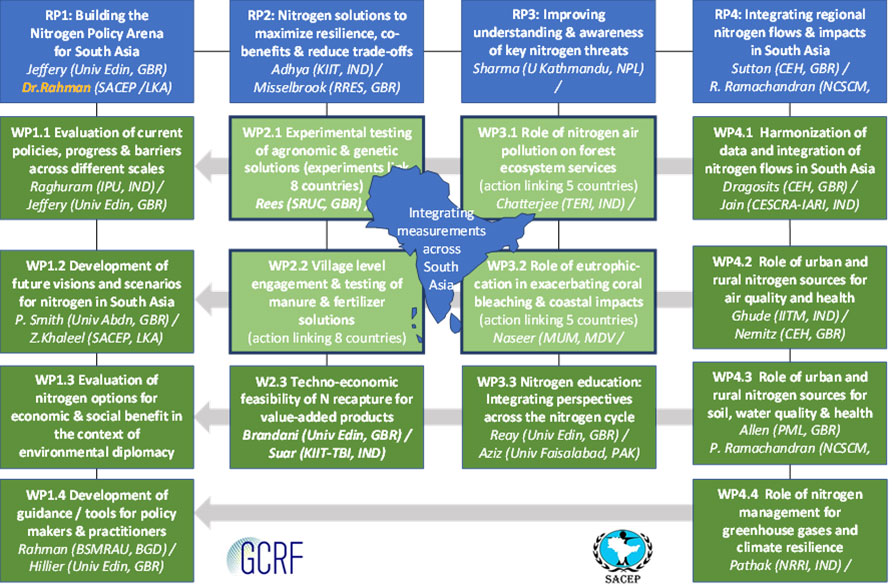
Nitrogen is one of the most abundant elements on Earth and is an essential element for life. However, due to reactive nitrogen added from human activity the natural Nitrogen Cycle is unable to neutralize the excess reactive nitrogen from the environment leaving the environment with excess reactive nitrogen. Excess reactive nitrogen compounds contribute to Water and Air pollution, effects on Greenhouse balance, effects on Ecosystems and Soil and can have knock on effect on health and ecosystem services. Their damaging effects are insufficiently appreciated; each has been treated in isolation for policy development.
| Name/Chemical formula | Source | Effect | Level of emission in South Asia (in Tonnes) |
|---|---|---|---|
| Nitrous Oxide (N2O) | Agriculture, industry and energy | Powerful GHG (~296 x CO2) Depletion of Ozone layer |
913,580 |
| Oxides of Nitrogen (NOx) | Transport, industry and energy | Air pollution Have negative impact of health Indirect GHG |
11,959,000 |
| Ammonia (NH3) | Manure, fertilizers and biomass burning | Causes eutrophication, affects biodiversity and health | 7,847,910 |
| Nitrate (NO3) | Waste water and Agriculture | Forms particulate matter in air Causes eutrophication in water / causes algal blooms and dead zones Affects health |
N/A |
Agricultural activities followed by energy and industry are the major source of nitrogen pollution in the region.South Asia is the second highest region in the globe in terms of nitrogen fertilizers use (21.8 million tonnes in 2016). In SA, agriculture and industry contribute massively to the region’s economy. South Asia, being the most populous (nearly 2 billion people) and the fastest growing region of the world with a distinct socio-economic, cultural and climatic profile there is growing demand for increased economic development and food production. And usable Nitrogen is lost to ground water and surface water bodies through agricultural run offs during rain, sewage, animal and human excreta, and also into the air due to emission of reactive N compounds from agricultural soils, livestock, sewage dumps, residue burning, vehicular and industrial emissions and industrial waste.
Thus, a large population is at risk from the negative impacts posed by nitrogen pollution. the coastal habitats of South Asia that are at a high risk of eutrophication due to the accumulation of reactive N, and deteriorating air quality concern for the development of fogs in New Delhi- India and Karachi-Pakistan during winter. There are already signs of large dead zones (where oxygen level is too low for life) in Bay of Bengal, whose well-being is depended upon by a large part of South Asian Fisheries industry and related livelihoods.
To highlight the issue and address it SACEP have worked for number years partnering with various international organizations

In partnership with South Asian Nitrogen Hub a Framework Policy on Nitrogen Management for South Asia region will be developed in order to regulate nitrogen at the national level through intergovernmental coordination mechanisms (i.e GC and IMM bodies). This will be a country driven approach and would be supported by scientific institutions under the SANH. Under SANH following activities are undertaken to complete the Policy Framework;
Latest Reports
#Nitrogen4NetZero is a developing initiative among UN member states in South Asia. Championed by H.E. the President of Sri Lanka to highlight the necessity of sustainable nitrogen management to meet climate goals during an important year for climate action.
The initiative is co-developed with the ‘GCRF South Asian Nitrogen Hub’, established by the UKRI Global Challenges Research Fund. Working closely with the South Asia Cooperative Environment Programme (SACEP), the nitrogen hub provides a contribution to the International Nitrogen Management System (INMS), a global science support process for international nitrogen policy development. The overall INMS effort is led by the UK Centre for Ecology & Hydrology, with support from the Global Environment Facility (GEF) on behalf of the UN Environment Programme.
The key message is that Net Zero will be impossible to achieve without action on nitrogen and highlighting that reducing nitrogen pollution offers multiple win-wins across sustainable development for air, water, biodiversity, stratospheric ozone depletion, soils, food and the economy. These issues have been recognized by the UN Environment Assembly ‘Resolution on Sustainable Nitrogen Management’, led by India (UNEP/EA.4/Res.14), and the Colombo Declaration, which have an ambition to halve nitrogen waste from all sources by 2030, offering the potential to save $100 billion annually.
Human alteration of the global nitrogen cycle is having multiple impacts relevant for all the COP26 campaigns and science themes. #Nitrogen4NetZero centres on developing Visions of NetZero, building on existing finding of nitrogen science. At the same time, sustainable nitrogen management offers benefits for Health by reducing air and water pollution and stratospheric ozone depletion. Concerning Climate Risk Assessment, there are significant nitrogen feedbacks. For example, reducing nitrogen air pollution (NOx, NH3, PM2.5) for health has a climate penalty that must be addressed alongside reducing emissions of the greenhouse gas nitrous oxide (N2O).
Key intersections with climate change includes: